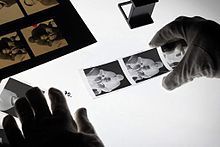Negative process
The term photographic process refers to the entirety of all techniques in photography that are used to create a negative photographic image . In the negative process, the material changes inversely to the degree of brightness and the color of the light: dark becomes light, light becomes dark. In order to obtain an image that is true to the original for humans, the process must then be reversed again (negative-positive process).
Important negative proceedings
The most important early photographic negative processes include:
- Photogenic drawing , between 1834 and 1839, William Henry Fox Talbot
- Calotype (also: Talbotype; 1841), William Henry Fox Talbot
- Photography (1839), naming for Talbot's method at about the same time by John FW Herschel and Johann Heinrich Mädler
- Steinheil procedure (1839), Carl August von Steinheil
- Albumen print (1848), Niepce de Saint-Victor
- Wet collodion process (or collodion wet plate ; 1850/51), Frederick Scott Archer and Gustave Le Gray
- Tannin Process (1861), Major Charles Russel
- Gelatin Drying Plate (1871), Richard Leach Maddox
See also
literature
- Otto Mente, Erich Lehmann, Willy Nauck: The negative process, the process of color photography, the processing of cinematographic films, photographic machine printing in its various versions (= handbook of photography. Vol. 2, 2). Union Deutsche Verlags-Gesellschaft, Berlin 1926.
